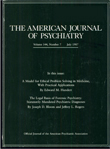The editors of Society and Health are to be commended for creating an outstanding volume of essays representing the direct contributions of 23 scholars and the indirect contributions of at least 22 thoughtful critics. The book's goals are to explore and bring into sharp focus the relationship between social factors/processes and health and to identify strategic points for interventions. It is useful to list the chapter titles to convey the range of topics covered: “Introduction,” “Family Pathways to Child Health,” “Community and Health,” “Race and Health,” “Gender, Health, and Cigarette Smoking,” “Explanations for Social Inequalities in Health,” “Political Economy and Health,” “Class, Work, and Health,” “The Cultural Frame,” “The Role of Medical Care in Determining Health,” and “Thinking Strategically About Society and Health.”
Each chapter reviews the relevant literature, and each includes a meaningful discussion of the most compelling conceptual challenges authors faced in presenting their topics. This feature gives an agenda-setting quality to the book. Two examples of this quality follow.
In “Race and Health,” Gary King and David R. Williams identify “the conceptual meaning and empirical application of the race variable in public health research” as two of the most compelling questions the scientific community and health professionals face in understanding the relationship between race and health status. The fact that researchers classify subjects into clear-cut racial categories when “pure races” do not exist raises questions about using the variable of race as “a proxy for biological, cultural, socioeconomic, and sociopolitical factors, as well as for [experienced] racism.”
As a second example of the book's agenda-setting quality, in “Community and Health,” Donald L. Patrick and Thomas M. Wickizer identify at least five compelling questions related to defining community and implementing effective community-level interventions. One question—how should community be defined?—is especially interesting. Patrick and Wickizer discuss three common definitions of community: community as place, community as social interaction, and community as social and political responsibility. They also encourage researchers to be innovative in their conceptualizations of community. Examples of innovative (yet overlapping) conceptualizations include the intentional community (created with a special purpose such as correcting environmental destruction), the temporary community (formed in times of crisis), and the personal community (pulling together people with common interests such as health clubs and volunteer networks). Obviously, definition is important because it helps to give focus to policy and intervention strategies.
The shortcomings of this book are minor. With regard to coverage, reviewers can always identify topics they would have covered (I would have included a chapter on the role of alternative medicine in determining health status). Likewise, it is easy to find some faults with the closing discussion and recommendations. In the final chapter, S.M. Miller points out that virtually every chapter in Society and Health lends support to the hypothesis that economic inequality may be bad for health. A comprehensive health care policy, therefore, should focus on reducing inequalities in resources and relations. This leaves readers with the nagging question of how to convince policy makers and others in positions of power to focus on reducing inequalities in the same way they have focused on finance reform and other cost-saving measures.

